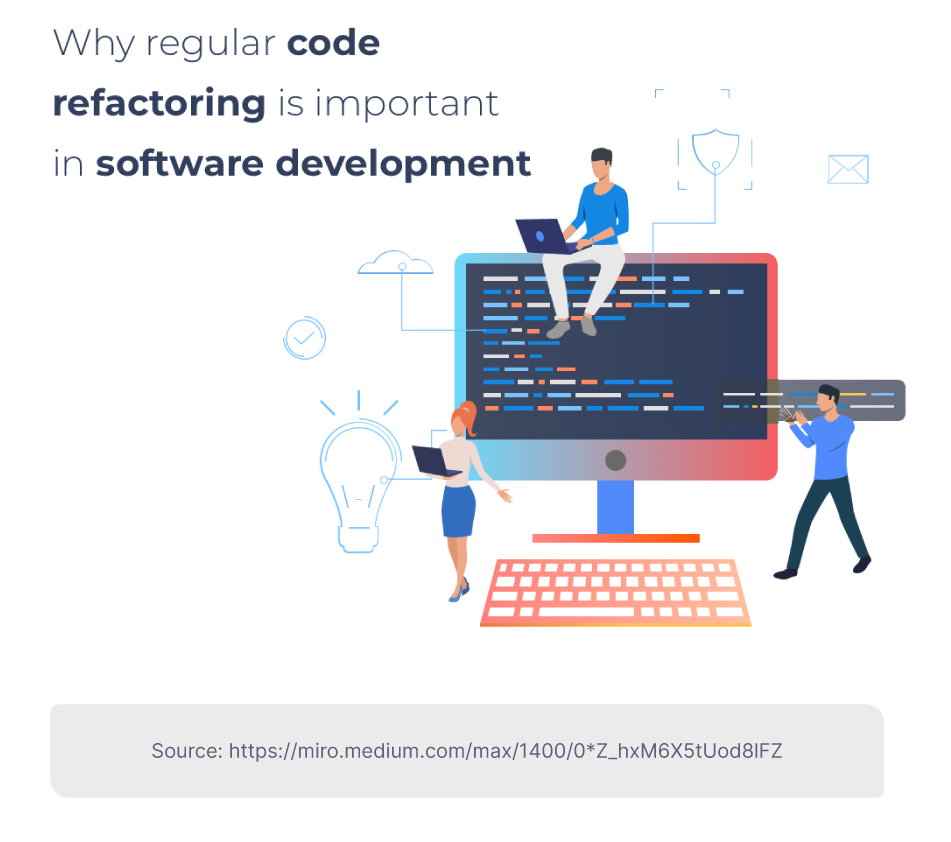Code Refactoring: 5 Reasons It Matters

Writing code is an iterative process. Unlike baking, you don’t just write the code once, get it as good as you can, take it out of the oven, and move on. Rather, code can be written over and over, each time gathering more effectiveness, better speed, more features, and fewer errors. But unlike baked goods -- which get eaten soon after they’re cooked -- code often outlives its initial use cases. And over time, this code gets…well, old. That’s where code refactoring comes in.
Unlike QA or testing, or building on code to produce more features and better functionality, code refactoring is the thankless project of making code better before it breaks. In other words, it’s like tidying up your room before your mom notices and yells at you for making an absolute mess. Or, for another comparison, it’s like giving your car a tune-up before it breaks down.
According to Geeks for Geeks, the definition of code refactoring is when “we restructure the code without changing the external behavior or functionality of the application.” It’s when you clean up the code before the code causes external problems -- i.e. making small (but positive) changes in your source code to avoid potential issues down the line, all while keeping all functionality the same.
This can look like many things, and it can have a range of benefits. But it’s always important, even if it feels tiresome to clean up code which isn't causing user problems. In other words, I hear you say, isn’t it good enough if the code works -- do we really have to worry about tidying and tweaking code that isn’t that bad?

In short: yes. Here are five reasons why refactoring matters especially if your code is working fine.
1. Spend (some) time to save (lots of) time.
Refactoring is preemptive maintenance which, and while it may cost you valuable time and resources on the front end, it can save you countless hours and significant program-power down the line. If you refactor correctly, you’ll make your software more efficient now, so that it continues to perform well for longer. So as practices change and new techniques are developed, your (future) code will need less work -- and your devs will need less time doing that work -- to ensure it all stays up to date. In other words, you’ll clean your room quickly now so you won’t have to clean as much later. Worth it? Yes.
2. Refactor when it’s fresh in your mind
Building software is a time and labor intensive process. We all know this. So it’s easy to feel resistant to working on functional code -- especially if you’ve just pushed the product to market and want to forget about it, to cast it aside, and to move on with your life. But right after code is shipped…turns out to be the best time to refactor your code. Why? Because that’s when it’s fresh in mind and when you’re most connected to the “why” of each choice, and that’s when you’ll be able to most effectively clean the code without creating any cascading issues. Sound tedious? Perhaps. Worth it? Yes.
3. Find bugs before they find you
Let’s say you’ve shipped your software. Congrats! What do you do next? Wait until users start discovering bugs and getting upset, asking for their money back, and leaving to use your competitors' software? Or do you go into the code and try to preemptively discover what might be buggy before your users do? I’d say the second one. No brainer. And that’s refactoring -- getting to those bugs before the bugs get to you. So pick up your (metaphorical) fly swatter and get to work finding those (sleeping) bugs. I promise it’ll be worth it later.
4. Make your good code great
Like we’ve said, it’s easy to consider finished code “done” -- but code is never actually done. Especially if you want your technology to be living and current. Refactoring is the right time, and the right process, to take your code and make it better. It’s a chance to review the intricacies of what you’ve written and not to stop and “OK” but to work on subtle changes and small tweaks to make that “OK” into “wow.” Don’t wait until your program is outdated -- help ensure it’s fast, safe, and smooth, so you can maintain and scale easier, sooner. Worth it? Of course.
-png.png)
5. Keep everything up to date
Often when we make code for the first time, we do what needs to be done, and not necessarily what could have been done -- especially if we’re under a time crunch, are understaffed, or just don’t know better. Refactoring allows us to update our code to the best practices and our most current knowledge, and to do so in a way which ensures we’ll be able to update our code with new features more easily in the future. Clean code is easier to work on, so why not invest in your future selves (and colleagues) who will be updating this software by making it as clean as it can possibly be now. It may not be easy, but I don’t have to tell you: it’s worth the time now.
Conclusion
Regardless of how well your software seems to be working, refracting is a good choice of how to spend your time. But that doesn’t mean it’s always necessary. If, for instance, an application needs to be entirely overhauled, from soup to nuts, then it’s likely not a good use of time to refactor -- rather, in this case, just start over. Likewise, if the code is too old or too outdated. In such a case, forget refactoring: either start over or just move on. This is what refactoring is meant to avoid. However, in the case that it’s too late, you are encouraged to cut your losses.
However, if that’s not the case, refactoring is likely a good call. Just make sure you schedule enough time; it can feel like a rabbit hole and is definitely never a “quick fix” -- especially if what you’re fixing isn’t even technically broken yet!
--
If you want to stay up to date with all the new content we publish on our blog, share your email and hit the subscribe button.
Also, feel free to browse through the other sections of the blog where you can find many other amazing articles on: Programming, IT, Outsourcing, and even Management.

With over +16 years of experience in the technology and software industry and +12 of those years at Jobsity, Santi has performed a variety of roles including UX/UI web designer, senior front-end developer, technical project manager, and account manager. Wearing all of these hats has provided him with a wide range of expertise and the ability to manage teams, create solutions, and understand industry needs. At present, he runs the Operations Department at Jobsity, creating a high-level strategy for the company's success and leading a team of more than 400 professionals in their work on major projects.